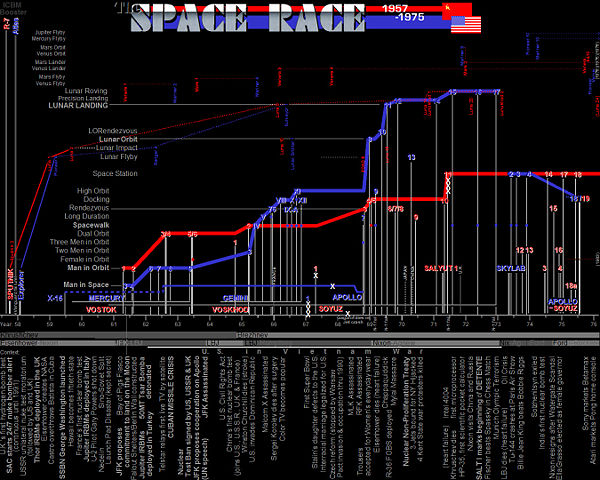Image:Space Race 1957-1975 .jpg
From Wikipedia, the free encyclopedia
 Size of this preview: 600 × 480 pixels
Size of this preview: 600 × 480 pixels Full resolution (1,350 × 1,080 pixels, file size: 430 KB, MIME type: image/jpeg)
 |
This is a file from the Wikimedia Commons. The description on its description page there is shown below.Commons is a freely licensed media file repository. You can help.
|
Summary
| Description |
English: This image takes significant events from the timeline of the Space Race from 1957 through 1975 and plots them into a y-axis that gauges the relative significance of those accomplishments. All human spaceflight programs are graphed along with leading events for unpiloted probes. It is all put in context of government leadership and selected technological, social and military events of that period as they happened under the shadow of the nuclear arms race. Three separate flows are charted. The first being unpiloted space probes toward the lunar goal as they evolved from Sputnik/Explorer to the lunar impactors, landers, rovers and sample return missions. The second (but PRIMARY in significance) being human spaceflight from Gagarin/Shepard up to the pinnacle of the Apollo Moon missions and back down to the Salyut/Skylab stations, then cooling off with Apollo/Soyuz (not covering the continued story of Shuttle/Buran and Mir/ISS). The third flow, shown at the top of the chart, covers leading interplanetary probes as they attained certain goals with varying success. Ending the timeline at Apollo/Soyuz puts achievements such as the Viking landers and Voyager missions off to the right of this chart. The parenthetical years shown at the right edge of the chart mark when that particular level was accomplished by the other country, such as Sally Ride becoming the first U.S. female in space in 1983, twenty years after Valentina Tereshkova. (Minority and non-government breakthroughs that happen after the mid-70s timeframe are not shown in this chart.) Displaying these accomplishments graphically makes it easy to see how the U.S. started behind but eventually caught up and surpassed the Soviet Union. The U.S. was a year behind in getting a "Man in Orbit", and then jumped ahead during the Gemini Program. The Soviets did not accomplish rendezvous and docking until three years after the U.S. did. The Soviets came very close to beating the U.S. in sending people around the Moon, but the Zond 5 spacecraft and subsequent attempts, although capable of carrying cosmonauts to the Moon, were not able to achieve a reliably survivable return to Earth. Major setbacks were followed by multiple failures of their N-1 Moon rocket and the Soviets never sent any cosmonauts beyond Earth orbit. With six Apollo Moon landings, the U.S. resoundingly won the Space Race. The Soviets continued to explore the Moon with robotic probes. Both nations continued sending probes to explore the solar system. Through diplomatic negotiations, a new era of Detente was ushered in to significantly calm the fear of nuclear war. After years of intense competition in space, the race was relaxed in 1975 with a dramatic display of cooperation on the Apollo-Soyuz mission.
|
| Source |
Own work by uploader, created in MSPaint using mainly Powerpoint with minor Photoshop (5x4 aspect ratio) |
| Date |
July 8, 2008 |
| Author |
Tdadamemd |
Permission
( Reusing this image) |
see below
|
Licensing:
I, the copyright holder of this work, hereby publish it under the following licenses:
 |
Permission is granted to copy, distribute and/or modify this document under the terms of the GNU Free Documentation license, Version 1.2 or any later version published by the Free Software Foundation; with no Invariant Sections, no Front-Cover Texts, and no Back-Cover Texts. A copy of the license is included in the section entitled " GNU Free Documentation license".
Aragonés | العربية | Asturianu | Беларуская (тарашкевіца) | Български | বাংলা | ইমার ঠার/বিষ্ণুপ্রিয়া মণিপুরী | Brezhoneg | Bosanski | Català | Cebuano | Česky | Dansk | Deutsch | Ελληνικά | English | Esperanto | Español | Eesti | Euskara | فارسی | Suomi | Français | Gaeilge | Galego | עברית | Hrvatski | Magyar | Bahasa Indonesia | Ido | Íslenska | Italiano | 日本語 | ქართული | ភាសាខ្មែរ | 한국어 | Kurdî / كوردی | Latina | Lëtzebuergesch | Lietuvių | Bahasa Melayu | Nnapulitano | Nederlands | Norsk (nynorsk) | Norsk (bokmål) | Occitan | Polski | Português | Română | Русский | Slovenčina | Slovenščina | Shqip | Српски / Srpski | Svenska | తెలుగు | ไทย | Tagalog | Türkçe | Українська | اردو | Tiếng Việt | Volapük | Yorùbá | 中文(简体) | 中文(繁體) | +/- |
You may select the license of your choice.
|
File history
Click on a date/time to view the file as it appeared at that time.
|
|
Date/Time |
Dimensions |
User |
Comment |
| current |
00:54, 9 July 2008 |
1,350×1,080 (430 KB) |
Tdadamemd |
|
File links
The following pages on Schools Wikipedia link to this image (list may be incomplete):
This file contains additional information, probably added from the digital camera or scanner used to create or digitize it. If the file has been modified from its original state, some details may not fully reflect the modified file.

